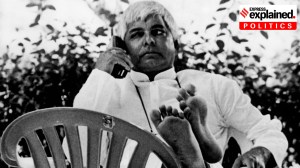Explained: Story of Chicken a la Kiev, the dish that rose to global popularity
As Prime Minister Narendra Modi lands in Kyiv (formerly Kiev), here is a look at the culinary favourite that might be many Indians’ first introduction to Ukraine
 Chicken a la Kiev is a classic in Anglo Indian restaurants. (Wikimedia Commons)
Chicken a la Kiev is a classic in Anglo Indian restaurants. (Wikimedia Commons)It might not actually be Ukrainian, but for many Indians, Chicken a la Kiev (or simply Chicken Kiev) used to be the very first window into the eastern European country. A staple of the so-called ‘continental’ cuisine, Chicken Kiev was among the classic dishes to give Indians a taste of Europe in an era when most Indians had limited avenues to learn about, let alone experience, the world.
Contested origins
Like many culinary classics, the origins of Chicken Kiev are contested. According to Russians Chicken Kiev originated in the Muscovy region of the old Russian Empire. Its modern-day name came from the recipe being perfected in the 19th century by a Ukrainian chef.
Till date, Ukrainian chefs claim to have the only authentic recipe for the dish — a chicken breast rolled around a butter sauce, covered in breadcrumbs, and fried/baked. Nonetheless, the dish may have actually originated in France, as a cousin to the French classic Cordon Bleu — breaded, fried meat rolled around a cheese sauce.
Viacheslav Gribov, then the head chef at Kyiv’s Hotel Dnipro, told NPR in 2013 that during the late 1840s, Russian royalty sent chefs to Paris to learn from the best. They returned with a dish they called Mikhailovska cutlet, which today goes by the name Chicken Kiev.
“The dish was made in Paris with veal… but in Moscow, it was made with chicken. At that time, chicken was more expensive and considered more of a delicacy,” Gribov said. Soon it became popular among Russian high society.
Global popularity
Chicken Kiev was likely introduced to Europe and the United States in the aftermath of the Russian Revolution in 1917 by aristocrats and anti-communists who fled to the West. The dish began appearing in the menus of posh New York and London restaurants in the 1920s, and gained popularity in the late 1940s, with chefs looking to lure the ever-growing population of Russian migrants in the West.
However, by most accounts, the dish was not all that popular in the Soviet Union. It was in the 1950s and 1960s, when tourists to Kiev began to ask for the eponymous dish, that it rose to the status in Ukraine that it enjoys today. In fact, some say that it was the dish which attracted tourists to the city. “Chicken Kiev made Kiev famous,” Gribov said.
In 1979, the dish jumped from being a staple in fancy restaurants to becoming a global sensation as a ready-to-eat dinner, first marketed by British supermarket chain Marks & Spencers. Such was the dish’s popularity that in the early 1980s, the British Office of National Statistics used it to measure inflation. “Affordable yet suffused with continental glamour, it came to stand for the increasing aspiration and affluence of the lower-middle classes – an idealised vision of Thatcher’s Britain,” an article in The Economist, published in 2019, said.
Today, there are many variations of the dish, some with more seasoning, others with cheese in addition to the butter. In India, where the dish remains a staple in the soon-vanishing breed of Anglo restaurants, the dish remains a nostalgic reminder of a bygone era when eating out was a rare luxury, and fried chicken with some butter sauce was as luxurious a dish there could be.



- 01
- 02
- 03
- 04
- 05


































